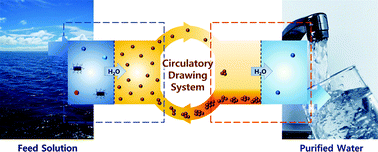Circulatory osmotic desalination driven by a mild temperature gradient based on lower critical solution temperature (LCST) phase transition materials†
Abstract
Abrupt changes in effective concentration and osmotic pressure of lower critical solution temperature (LCST) mixtures facilitate the design of a continuous desalination method driven by a mild temperature gradient. We propose a prototype desalination system by circulating LCST mixtures between low and high temperature (low T and high T) units. Water molecules could be drawn from a high-salt solution to the LCST mixture through a semipermeable membrane at a temperature lower than the phase transition temperature, at which the effective osmotic pressure of the LCST mixture is higher than the high-salt solution. After transfer of water to the high T unit where the LCST mixture is phase-separated, the water-rich phase could release the drawn water into a well-diluted solution through the second membrane due to the significant decrease in effective concentration. The solute-rich phase could be recovered in the low T unit via a circulation process. The molar mass, phase transition temperature, and aqueous solubility of the LCST solute could be tuneable for the circulatory osmotic desalination system in which drawing, transfer, release of water, and the separation and recovery of the solutes could proceed simultaneously. Development of a practical desalination system that draws water molecules directly from seawater and produces low-salt water with high purity by mild temperature gradients, possibly induced by sunlight or waste heat, could be attainable by a careful design of the molecular structure and combination of the circulatory desalination systems based on low- and high-molar-mass LCST draw solutes.


 Please wait while we load your content...
Please wait while we load your content...